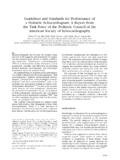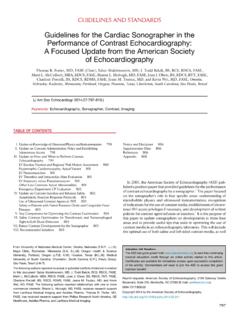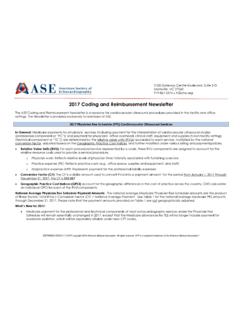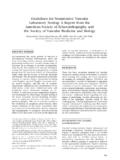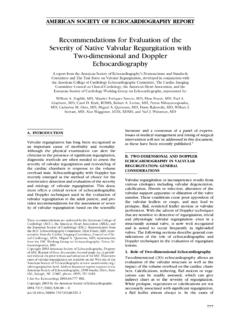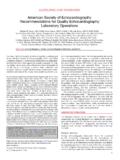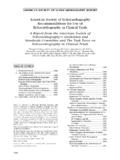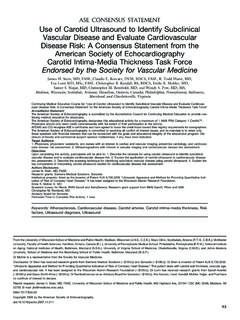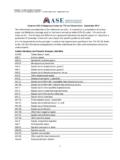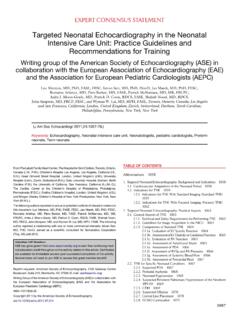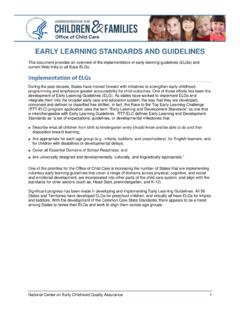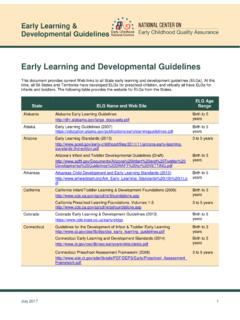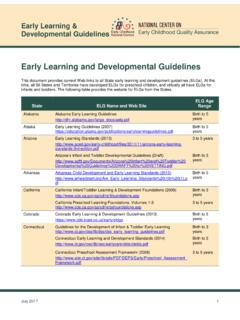Transcription of Guidelines and Standards for Performance of a Pediatric ...
1 Guidelines and Standards for Performance ofa Pediatric Echocardiogram: A Report fromthe Task Force of the Pediatric Council of theAmerican Society of EchocardiographyWyman W. Lai, MD, MPH, FASE, Tal Geva, MD, FASE, Girish S. Shirali, MD,Peter C. Frommelt, MD, Richard A. Humes, MD, FASE, Michael M. Brook, MD,Ricardo H. Pignatelli, MD, and Jack Rychik, MD, Writing Committee,New York, New York;Boston, Massachusetts; Charleston, South Carolina; Milwaukee, Wisconsin; Detroit, Michigan; San Francisco, California;Houston, Texas; and Philadelphia, PennsylvaniaEchocardiography has become the primary imag-ing tool in the diagnosis and assessment of congen-ital and acquired heart disease in infants, children,and adolescents. Transthoracic echocardiography(TTE) is an ideal tool for cardiac assessment, as it isnoninvasive, portable, and efficacious in providingdetailed anatomic, hemodynamic, and physiologicinformation about the Pediatric for Standards in the performanceof a routine 2-dimensional (2D)
2 Echocardiogram, 1 fetalechocardiogram,2 Pediatric transesophageal echocar-diogram,3 intraoperative transesophageal echocar-diogram,4 and stress echocardiogram5 exist, as doguidelines for appropriate training in various echo-cardiographic As part of the accredi-tation process for echocardiography laboratories,the Intersocietal Commission for the Accreditationof Echocardiography Laboratories has establishedbasic Performance Standards for Pediatric TTE, 13 butno other Standards document exists for the perfor-mance of a Pediatric Pediatric echocardiogram is a unique exami-nation with features that distinguish it from otherechocardiograms. There is a wide spectrum ofanomalies encountered in patients with congenitalheart disease. Certain views are of added importancefor Pediatric examinations: the subxiphoid (or sub-costal), suprasternal notch, and right parasternalviews. The acquisition and proper display of imagesfrom these views are critical aspects of the pediatricTTE.
3 In addition, special techniques are required forimaging uncooperative infants and young children,including sedation and distraction tools that willallow Performance of a complete purposes of this document are to: (1) de-scribe indications for Pediatric TTE; (2) define opti-mal instrumentation and laboratory setup for pedi-atric echocardiographic examinations; (3) provide aframework of necessary knowledge and training forsonographers and physicians; (4) establish an exam-ination protocol that defines necessary echocardio-graphicwindows and views; (5) establish a base-line list of recommended measurements to beperformed in a complete Pediatric echocardio-gram; and (6) discuss reporting requirements andformatting of Pediatric of indications for an echocardiogram isimportant to obtain the information required for thediagnosis and proper treatment of the pediatricpatient. The general categories of indications areprovided below, with emphasis placed on the indi-cations for a Pediatric echocardiogram versus astandard adult study.
4 For detailed age-specific lists ofindications, the reader is referred to prior with suggested or known heart diseasefrequently require serial studies to evaluate theevolution or progression of heart disease. Serialstudies may be indicated at routine intervals formonitoring of valve function, growth of cardiovas-cular structures, ventricular function, and potentialsequelae of medical or surgical the Mount Sinai Medical Center, New York ( );Children s Hospital, Boston ( ); Medical University of SouthCarolina, Charleston ( );Children s Hospital of Wisconsin,Milwaukee ( ); Children s Hospital of Michigan, Detroit( ); University of San Francisco ( ); Texas Children sHospital, Houston ( ); and Children s Hospital of Philadel-phia ( ).Reprint requests: Wyman W. Lai, MD, MPH, FASE, Division ofPediatric Cardiology, Box 1201, Mount Sinai Medical Center, OneGustave L. Levy Place, New York, NY Am Soc Echocardiogr 2006;19 $ 2006 by the American Society of Heart Disease: History, Symptoms,and SignsIndications for the Performance of a Pediatric echo-cardiogram span a wide range of symptoms andsigns, including cyanosis, failure to thrive, exercise-induced chest pain or syncope, respiratory distress,murmurs, congestive heart failure, abnormal arterialpulses, or cardiomegaly.
5 These may suggest catego-ries of structural congenital heart disease includingintracardiac left-to-right or right-to-left shunts, ob-structive lesions, regurgitant lesions, transpositionphysiology, abnormal systemic or pulmonary venousconnections, conotruncal anomalies, coronary ar-tery anomalies, functionally univentricular hearts,and other complex lesions, including abnormal lat-erality (heterotaxy/isomerism).Certain syndromes,family history of inherited heart disease, andextracardiac abnormalities that are known to beassociated with congenital heart disease consti-tute clinical scenarios for which echocardiogra-phy is indicated even in the absence of specificcardiac symptoms and signs. Abnormalities onother tests such as fetal echocardiography, chestradiograph, electrocardiogram, and chromosomalanalysis constitute another group in which thesuggestion of congenital heart disease is addressedspecifically by Heart Diseases and NoncardiacDiseasesAn echocardiogram is indicated for the evaluation ofacquired heart diseases in children, including Ka-wasaki disease, infective endocarditis, all forms ofcardiomyopathies, rheumatic fever and carditis, sys-temic lupus erythematosus, myocarditis, pericardi-tis, HIV infection, and exposure to cardiotoxicdrugs.
6 Pediatric echocardiography is indicated in theassessment of potential cardiac or cardiopulmonarytransplant donors and transplant recipients. Re-cently, echocardiography has been recommended inall children who are newly diagnosed with Noncardiac disease states that affectthe heart such as pulmonary hypertension consti-tute an important indication for serial pediatricechocardiograms. Echocardiography may also beindicated in children with thromboembolic events,indwelling catheters and sepsis, or superior venacava with arrhythmias may have underlyingstructural cardiac disease such as congenitally cor-rected transposition or Ebstein s anomaly of thetricuspid valve, which may be associated with subtleclinical findings and are best evaluated using echo-cardiography. Sustained arrhythmias or antiarrhyth-mic medications may lead to functional perturba-tions of the heart that may only be detectable byechocardiography and have important implicationsfor , PATIENT PREPARATION,AND PATIENT SAFETYI nstrumentationUltrasound instruments used for diagnostic studiesshould include, at a minimum, hardware and softwareto perform M-mode, 2D imaging, color flow mapping,and spectral Doppler studies, including pulsed waveand continuous wave capabilities.
7 The transducersused in Pediatric studies should provide adequateimaging across the wide range of depths encounteredin Pediatric cases. Multiple imaging transducers, rang-ing from low frequency ( MHz) to high frequency( MHz), should be available; a multifrequencytransducer that includes all these frequencies is also anoption. A transducer dedicated to the Performance ofcontinuous wave Doppler studies should also be avail-able for each video screen and display should be of suitablesize and quality for observation and interpretation of allthe above modalities. The display should identify theparent institution, a patient identifier, and the date andtime of the study. The electrocardiogram should alsobe displayed in real time with the echocardiographicsignal. Range or depth markers should be available onall displays. Measurement capabilities must be presentto allow measurement of the distance between twopoints, an area on a 2D image, blood flow velocities,time intervals, and peak and mean gradients fromspectral Doppler Acquisition and StorageEchocardiographic studies must be recorded andstored as moving images and must be stored on amedium that allows for playback of the recordedmoving images.
8 This would include videotape ordigital recording media. It is unacceptable to storeor archive moving echocardiographic images on amedium that displays only a static image, such asrecording film or paper. Portions of the echocardio-graphic examination such as M-mode frames andDoppler spectral measurements may be displayedand recorded as a static image on media appropriateto the laboratory Preparation and SafetySufficient time should be allotted for each study ac-cording to the procedure type. The Performance timeof an uncomplicated, complete (imaging and Doppler) Pediatric TTE examination is generally 45 to 60 min-utes (from patient encounter to departure). Additionaltime may be required for complicated studies. Allprocedures should be explained to the patient and/orJournal of the American Society of Echocardiography1414 Lai et alDecember 2006parents or guardians before the onset of the study. Thepatient should be placed in a reclining position in acomfortable environment.
9 A darkened room is prefer-able for the Performance of the study. Appropriatepillows and blankets should be used for patient com-fort and privacy. The sonographic gel should bewarmed to body temperature before the start of theexamination. It is recommended that appropriate dis-tractions be provided in echocardiographic laborato-ries performing studies on preschool children. Thesemay include toys, games, television, or movies. Aparent or guardian should accompany all childrenduring the echocardiographic study except whereprivacy issues laboratory should recognize the potentialneed for sedation of Pediatric patients to obtain anadequate examination. Written policies including,but not limited to, the type of sedatives, appropriatedosing for age and size, and proper monitoring ofchildren during and after the examination shouldexist for the use of conscious sedation in ,21 Each laboratory should have a written procedurein place for handling acute medical emergencies inchildren.
10 This should include a fully equipped car-diac arrest cart (crash cart) and other necessaryequipment for responding to medical emergenciesin Pediatric patients of all AND KNOWLEDGEE chocardiography of congenital and acquired pedi-atric heart disease is an operator-dependent imagingtechnique that requires high levels of technical andinterpretive skills to maximize its diagnostic accu-racy. Specialized training is required in the assess-ment of cardiovascular malformations to determinetreatment options and to assess outcomes after anever-increasing number of interventional and surgi-cal TTE is the primary diagnostic imaging mo-dality in children with heart disease, Pediatric cardi-ologists must possess basic skills in Performance andinterpretation of transthoracic cardiac ultrasound,including M-mode, 2D imaging, and various Dopplermethods. Physicians who specialize in echocardiog-raphy of Pediatric heart disease undergo extendedtraining in this committee reviewed and considered exist-ing Guidelines for training in Pediatric ,22-24 The American College of Cardiol-ogy (ACC) Pediatric Cardiology/Congenital HeartDisease Committee and the ACC Training ProgramDirectors Committee have jointly developed newrecommendations for training in Pediatric cardiol-ogy.
